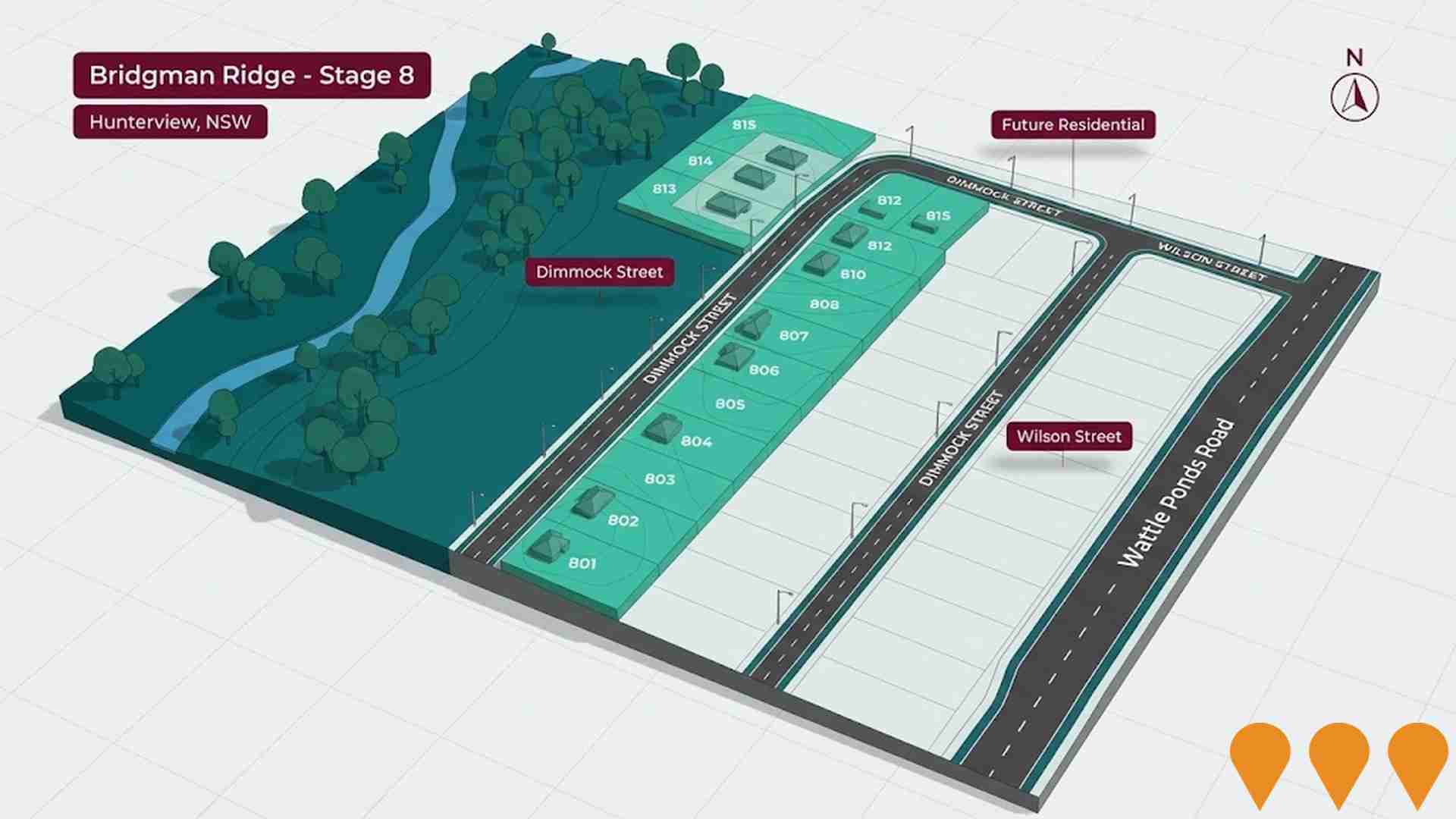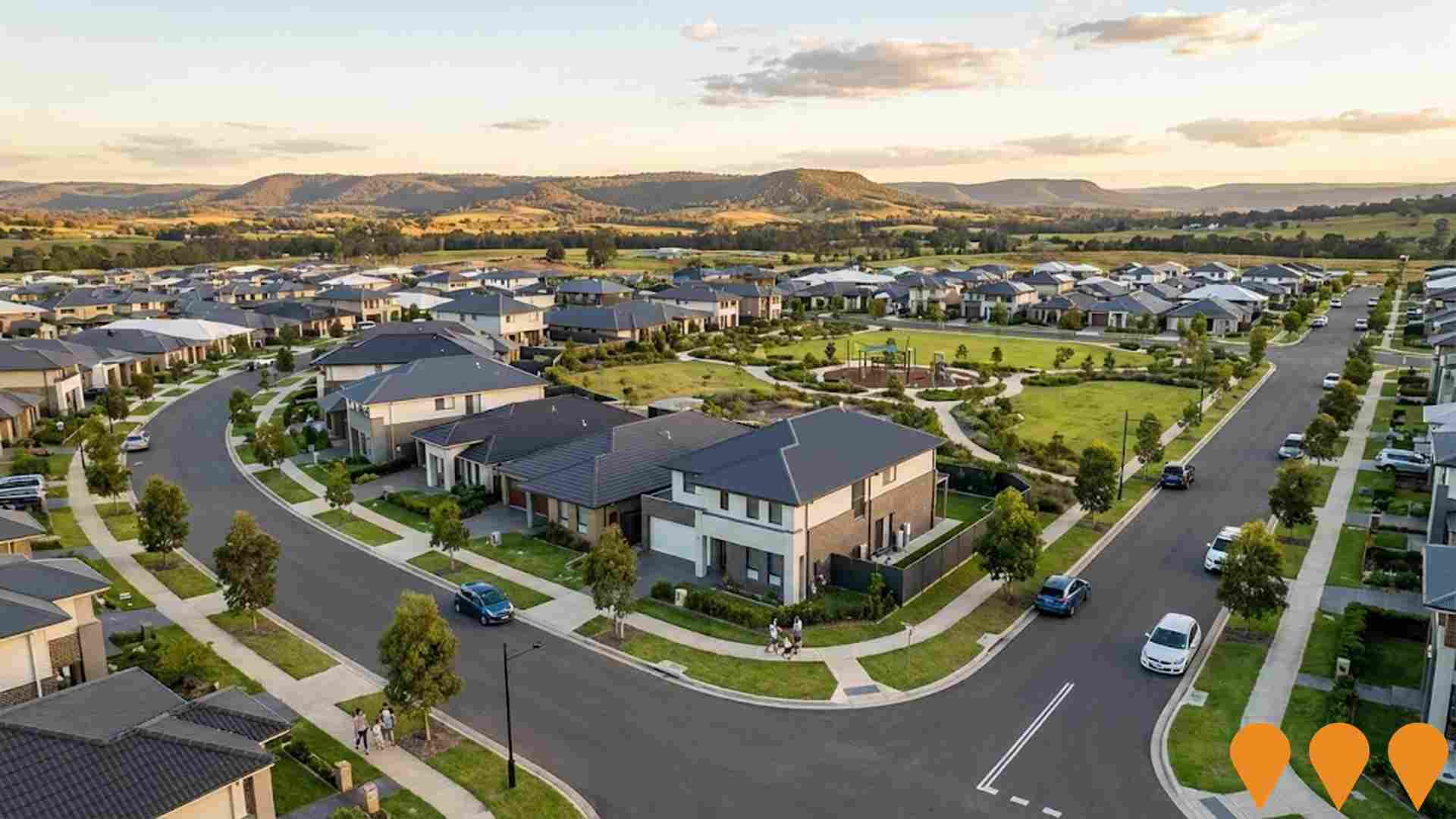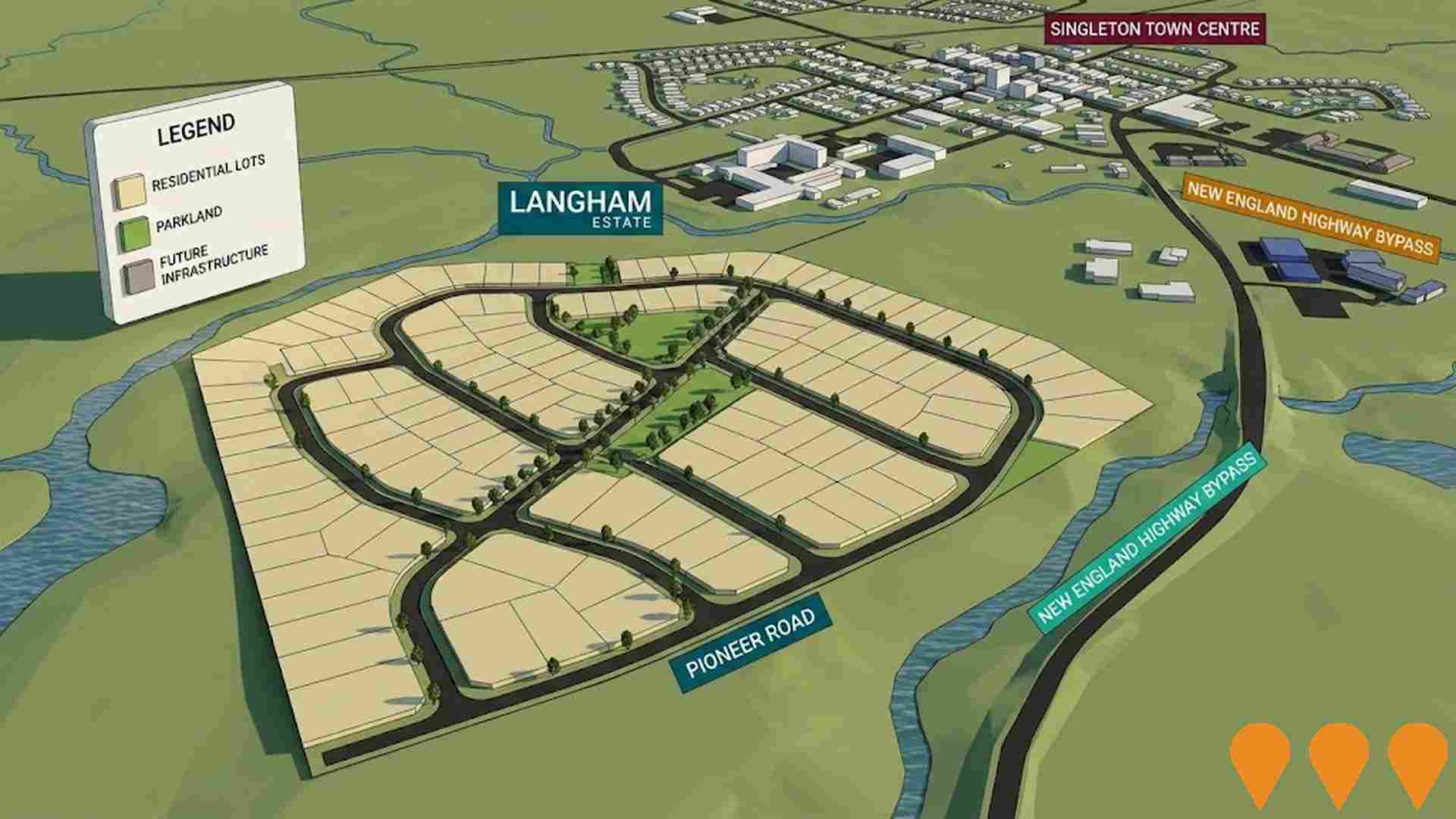Chart Color Schemes
est. as @ -- *
ABS ERP | -- people | --
2021 Census | -- people
Sales Activity
Curious about local property values? Filter the chart to assess the volume and appreciation (including resales) trends and regional comparisons, or scroll to the map below view this information at an individual property level.
Find a Recent Sale
Sales Detail
Population
Population growth drivers in Singleton Surrounds are strong compared to national averages based on AreaSearch's ranking of recent, and medium to long-term trends
Singleton Surrounds' population is approximately 5,507 as of August 2025. This figure represents an increase of 175 people from the 2021 Census count of 5,332 individuals, reflecting a growth rate of 3.3%. The projected resident population was estimated at 5,480 by the Australian Bureau of Statistics (ABS) as of June 2024, with an additional 94 validated new addresses since the Census date contributing to this increase. This results in a population density ratio of 1.4 persons per square kilometer. Singleton Surrounds' growth rate since the census is comparable to that of non-metro areas, being within 1.5 percentage points (3.3% vs 4.8%). Natural growth accounted for approximately 67.0% of overall population gains during recent periods, with overseas and interstate migration also contributing positively.
AreaSearch uses ABS/Geoscience Australia projections for each SA2 area, released in 2024 with a base year of 2022. For areas not covered by this data, AreaSearch employs NSW State Government's SA2 level projections released in 2022 using a base year of 2021. Growth rates by age group from these aggregations are applied to all areas for the years 2032 to 2041. Based on projected demographic shifts, regional areas across the nation are expected to experience above-median population growth. Singleton Surrounds is projected to increase by 904 persons by 2041, representing a total increase of 15.9% over the 17-year period.
Frequently Asked Questions - Population
Development
AreaSearch analysis of residential development drivers sees Singleton Surrounds recording a relatively average level of approval activity when compared to local markets analysed countrywide
Singleton Surrounds has recorded approximately 14 residential properties granted approval per year over the past five financial years, totalling 70 homes. In FY26 so far, 3 approvals have been recorded. On average, 3.7 people moved to the area annually for each dwelling built between FY21 and FY25. This high demand outpaces supply, typically driving up prices and increasing competition among buyers.
The average construction value of new homes is $468,000. In this financial year, $33.6 million in commercial approvals have been registered, indicating significant local commercial activity. Compared to the rest of NSW, Singleton Surrounds has 75.0% lower building activity per person, which usually reinforces demand and pricing for existing dwellings. This is also below national average, suggesting possible planning constraints. All recent development consists of detached dwellings, preserving the area's low density nature and attracting space-seeking buyers with approximately 323 people per dwelling approval.
Population forecasts indicate Singleton Surrounds will gain 877 residents by 2041. Building activity is keeping pace with growth projections, but buyers may face heightened competition as the population grows.
Frequently Asked Questions - Development
Infrastructure
Singleton Surrounds has limited levels of nearby infrastructure activity, ranking in the 0thth percentile nationally
Changes to local infrastructure significantly influence an area's performance. AreaSearch has identified 121 projects that could impact the area. Notable projects include New England Highway - Singleton Bypass, Singleton Centre Redevelopment, Bridgman Ridge Estate - Hunterview, and Langham Estate - Hunterview. The following list details those most relevant.
Professional plan users can use the search below to filter and access additional projects.
INFRASTRUCTURE SEARCH
 Denotes AI-based impression for illustrative purposes only, not to be taken as definitive under any circumstances. Please follow links and conduct other investigations from the project's source for actual imagery. Developers and project owners wishing us to use original imagery please Contact Us and we will do so.
Denotes AI-based impression for illustrative purposes only, not to be taken as definitive under any circumstances. Please follow links and conduct other investigations from the project's source for actual imagery. Developers and project owners wishing us to use original imagery please Contact Us and we will do so.
Frequently Asked Questions - Infrastructure
New England Highway - Singleton Bypass
An $800 million (revised) Australian and NSW Government-funded project to construct an 8 km bypass of Singleton on the New England Highway. The bypass will remove up to 15,000 vehicles per day (including heavy freight) from the town centre, improving safety, traffic flow and amenity. Key features include six bridges, notably a 1.6 km bridge over the Hunter River and floodplains. Major construction is well underway with the project on track to open to traffic in late 2027.
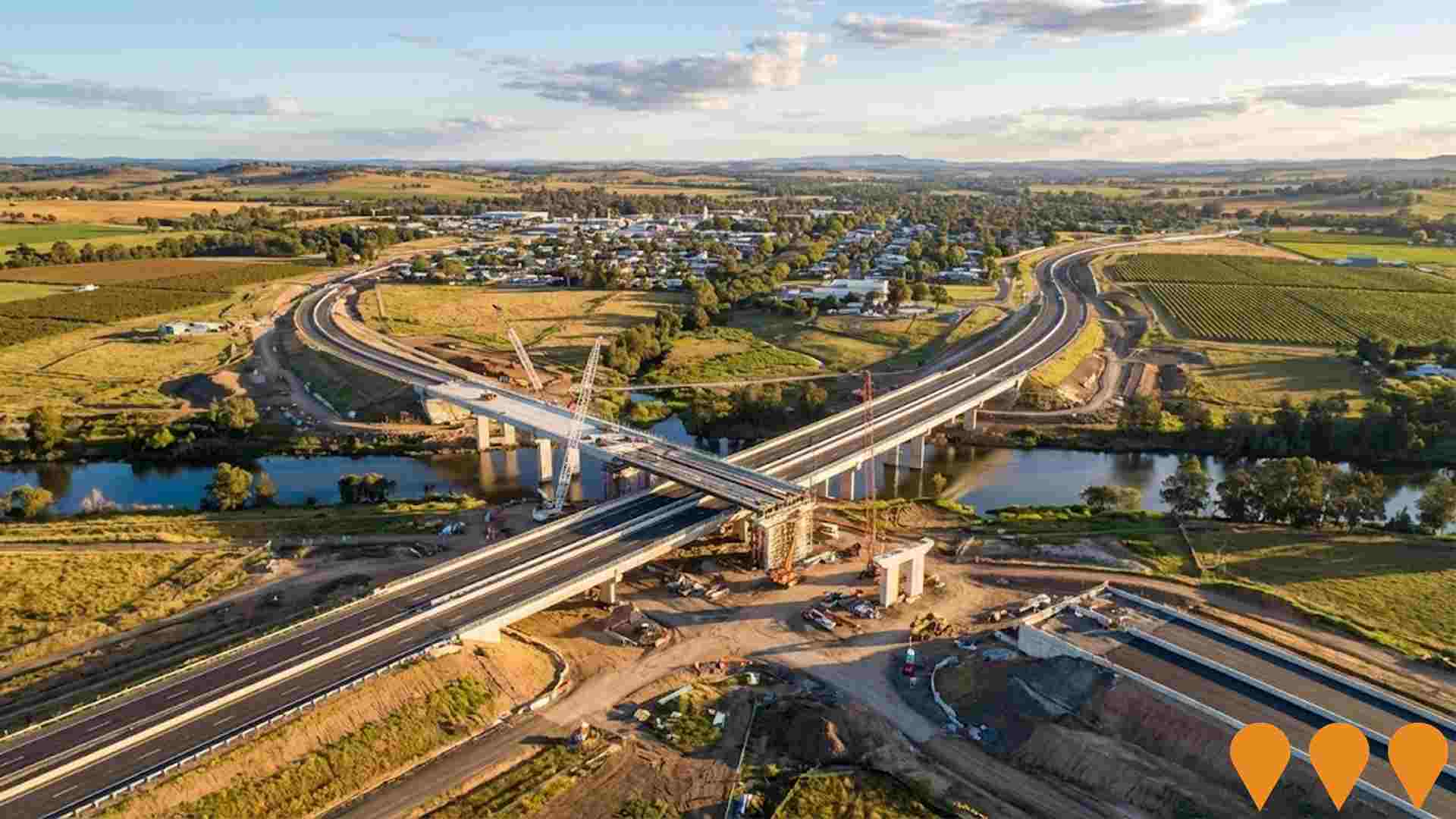
Singleton Centre Redevelopment
Redevelopment of the former Singleton Town Square into a mixed-use medical and services precinct. The transformation includes the largest medical facility in Singleton featuring Alto Imaging radiology clinic with X-ray, Ultrasound, CT and MRI services, Ungooroo Aboriginal Corporation GP and specialist medical suites, Happy Health occupational health services, pathology services by Australian Clinical Labs, sessional specialist medical suites, a World Gym fitness facility (opening June 2025), Wattaka Cafe, and various office tenancies. The centre provides 140 undercover car spaces and shared reception services for medical tenants.
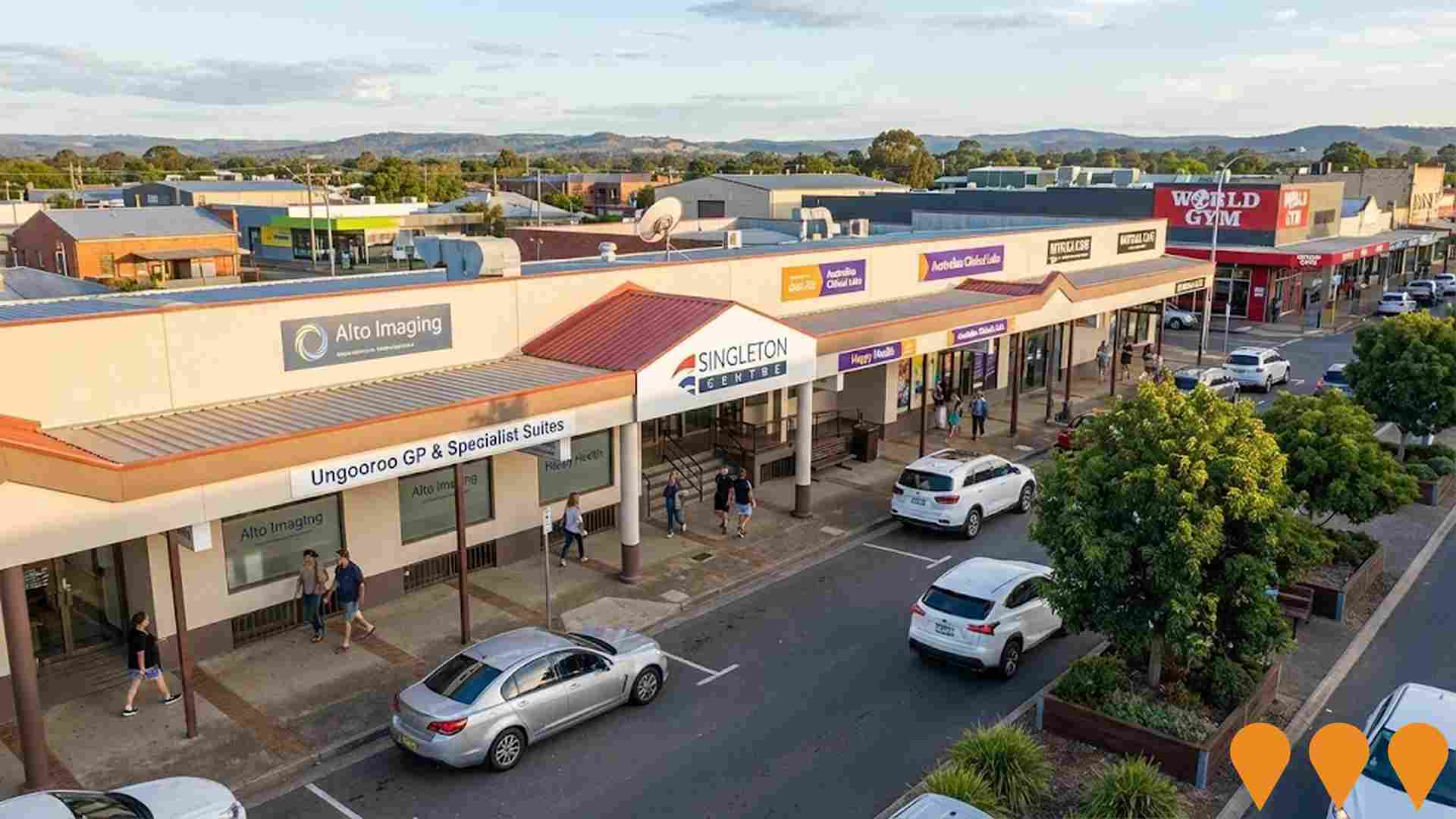
Singleton Town Centre Master Plan
A master plan adopted by Singleton Council to guide the revitalisation and public domain improvements of the Singleton town centre. The plan aims to enhance amenity, sustainability, and attractiveness to support visitation and liveability. It includes upgrades to streets, footpaths, lighting, and public spaces.

Singleton Arts and Cultural Centre
A community-based regional cultural facility featuring over 300 square metres of state-of-the-art exhibition space, two artists' workshops (wet and digital studios), and housing Singleton's Civic Art Collection. The Centre provides engaging exhibitions of contemporary art by local, regional, national, and international artists, alongside public events, lectures, activities and workshops for all ages. Located in Singleton's Townhead Park precinct with the Visitor Information Centre, ParkView Cafe, and children's playground.
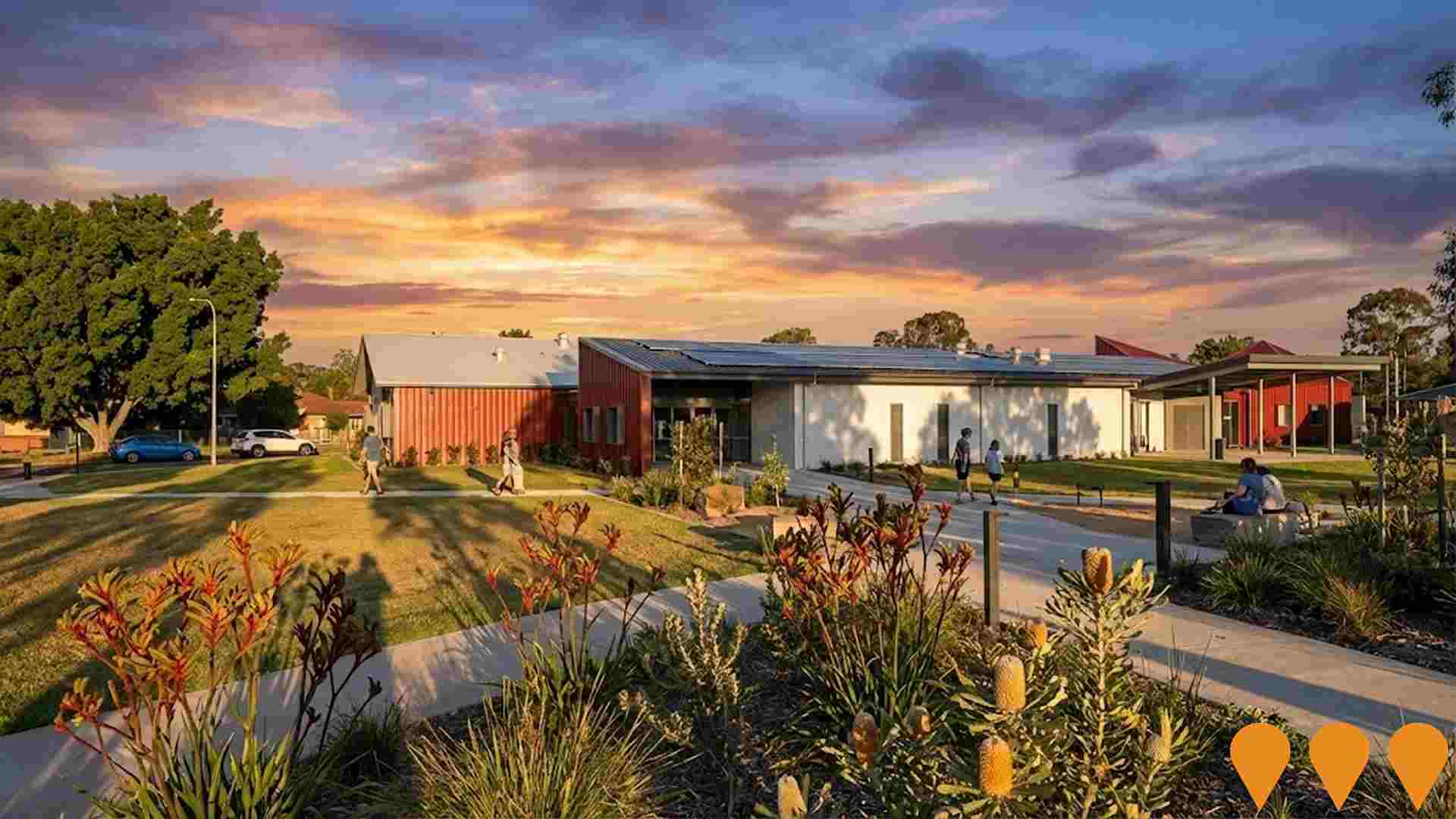
Singleton Housing Acceleration Plan
State Government initiative under the Regional Housing Strategic Planning Fund providing $120,671 to Singleton Council for planning control review to accelerate and unlock 2,113 new homes in the Singleton local government area. The project aims to address housing supply through strategic planning, developing and updating housing strategies, and bringing forward diverse and affordable housing options across the region.
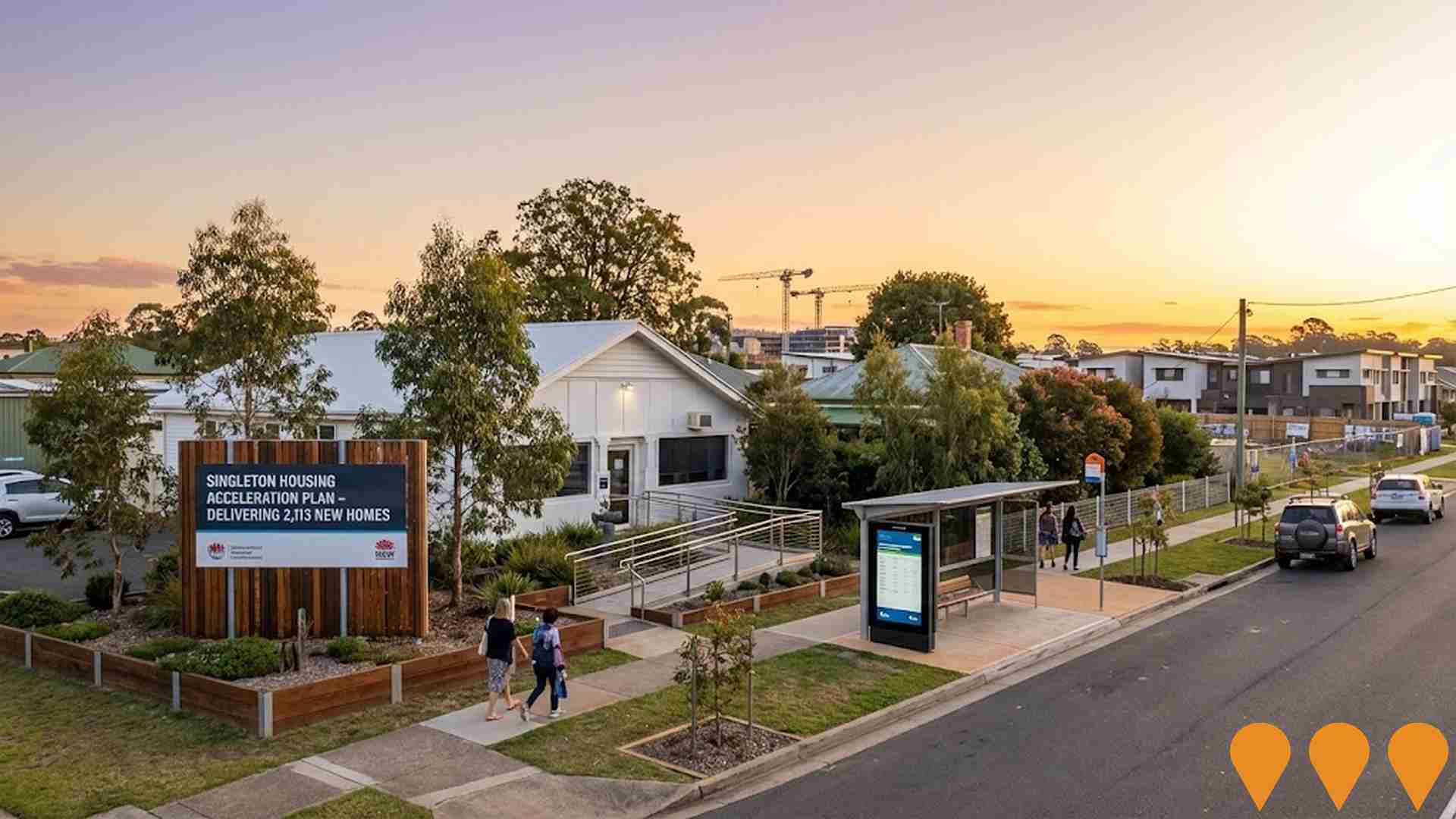
Singleton Gym + Swim Redevelopment
Comprehensive redevelopment of Singleton's premier aquatic and leisure facility completed in stages between 2016-2025. Major improvements include extension of gym facilities, construction of a new hydrotherapy/program pool, spin studio, creche, car park extension, and upgraded male, female and accessible changerooms. The facility now features a health club, group fitness classes, seasonal 50m outdoor pool, indoor heated 25m pool, 12.5m indoor heated programs pool, hydrotherapy pool, sauna and spa. Managed by Belgravia Leisure as part of the Singleton Active Group. Additional splash pad project worth $1.5M currently under construction for completion November 2025.

Alroy Oval Sports Precinct Redevelopment
Major upgrade of the sports precinct delivering 95% of the Alroy Oval Masterplan. The project includes demolition of existing facilities and construction of three full-sized irrigated and floodlit football fields, a new female-friendly and gender-neutral amenities building with change rooms, canteen and storerooms, upgraded car park with improved lighting, new footpaths, and enhanced personal safety features. Designed in collaboration with GroupGSA architects to promote participation in organised sports, particularly football, among women and girls. The facility will serve as the home hub for Singleton Strikers Football Club and the wider community.

Hunter Gas Pipeline
A proposed underground natural gas pipeline connecting the gas hub at Wallumbilla in Queensland to Newcastle and the Sydney market. The pipeline route passes through the Singleton local government area.

Employment
Employment conditions in Singleton Surrounds demonstrate strong performance, ranking among the top 35% of areas assessed nationally
Singleton Surrounds has a balanced workforce with representation across white and blue collar jobs. Manufacturing and industrial sectors are strongly represented, and the unemployment rate is 2.0%.
As of June 2025, there are 2,842 residents employed, with an unemployment rate of 1.6% lower than Rest of NSW's rate of 3.7%. Workforce participation in Singleton Surrounds is 62.1%, compared to Rest of NSW's 56.4%. Key industries of employment among residents are mining, agriculture, forestry & fishing, and construction. Mining shows notable concentration with employment levels at 9.2 times the regional average.
Conversely, health care & social assistance has lower representation at 7.3% versus the regional average of 16.9%. There is a ratio of 1.5 workers to every resident, indicating it functions as an employment hub hosting more jobs than residents and attracting workers from surrounding areas. Between June 2024 and June 2025, the labour force decreased by 4.3% while employment decreased by 4.6%, causing unemployment to rise by 0.3 percentage points. In comparison, Rest of NSW recorded an employment decline of 0.1%, labour force growth of 0.3%, with unemployment rising 0.4 percentage points. Jobs and Skills Australia's national employment forecasts from May 2025 project national employment expansion by 6.6% over five years and 13.7% over ten years, but growth rates vary significantly between industry sectors. Applying these projections to Singleton Surrounds' employment mix suggests local growth of approximately 4.8% over five years and 11.1% over ten years.
Frequently Asked Questions - Employment
Income
The area exhibits notably strong income performance, ranking higher than 70% of areas assessed nationally through AreaSearch analysis
Singleton Surrounds' income level is very high nationally according to the latest ATO data aggregated by AreaSearch for financial year 2022. Singleton Surrounds' median income among taxpayers is $55,360 and the average income stands at $73,821. These figures compare to Rest of NSW's median income of $49,459 and average income of $62,998 respectively. Based on Wage Price Index growth of 12.61% since financial year 2022, current estimates would be approximately $62,341 (median) and $83,130 (average) as of September 2025. According to 2021 Census figures, household income ranks at the 67th percentile ($2,034 weekly), while personal income sits at the 44th percentile. Distribution data shows that 29.6% of residents (1,630 people) fall into the $1,500 - 2,999 bracket, mirroring regional levels where 29.9% occupy this bracket. Singleton Surrounds demonstrates considerable affluence with 30.4% earning over $3,000 per week. After housing costs, residents retain 86.8% of income, reflecting strong purchasing power and the area's SEIFA income ranking places it in the 5th decile.
Frequently Asked Questions - Income
Housing
Singleton Surrounds is characterized by a predominantly suburban housing profile, with above-average rates of outright home ownership
Singleton Surrounds' dwelling structure in its latest Census evaluation showed 98.9% houses and 1.1% other dwellings (semi-detached, apartments, 'other' dwellings), contrasting with Non-Metro NSW's 90.9% houses and 9.0% other dwellings. Home ownership within Singleton Surrounds stood at 41.0%, with mortgaged dwellings at 40.5% and rented ones at 18.5%. The median monthly mortgage repayment was $2,167, surpassing Non-Metro NSW's average of $1,733. Meanwhile, the median weekly rent figure in Singleton Surrounds was $360, compared to Non-Metro NSW's $340. Nationally, mortgage repayments were significantly higher at $2,167 than the Australian average of $1,863, while rents were lower at $360 compared to the national figure of $375.
Frequently Asked Questions - Housing
Household Composition
Singleton Surrounds features high concentrations of family households, with a higher-than-average median household size
Family households comprise 80.7% of all households, including 39.6% couples with children, 32.0% couples without children, and 8.2% single parent families. Non-family households account for the remaining 19.3%, with lone person households at 17.5% and group households making up 1.8%. The median household size is 2.8 people, larger than the Rest of NSW average of 2.6.
Frequently Asked Questions - Households
Local Schools & Education
Singleton Surrounds faces educational challenges, with performance metrics placing it in the bottom quartile of areas assessed nationally
The area has lower university qualification rates at 13.7% compared to NSW's average of 32.2%. Bachelor degrees are the most common at 10.6%, followed by postgraduate qualifications (1.8%) and graduate diplomas (1.3%). Vocational credentials are held by 47.7% of residents aged 15+, with advanced diplomas at 9.7% and certificates at 38.0%. Educational participation is high, with 30.6% currently enrolled in formal education: 12.4% in primary, 9.2% in secondary, and 2.4% in tertiary education.
Singleton Surrounds has four schools with a combined enrollment of 115 students, all focusing on primary education. Secondary options are available in surrounding areas. Local school capacity is limited at 2.1 places per 100 residents compared to the regional average of 13.0, leading many families to travel for schooling.
Frequently Asked Questions - Education
Schools Detail
Nearby Services & Amenities
Transport
Transport servicing is low compared to other areas nationally based on assessment of service frequency, route connectivity and accessibility
Singleton Surrounds has 173 active public transport stops, all of which are bus stops. These stops are served by 32 different routes that together offer 240 weekly passenger trips. The accessibility of these services is rated as moderate, with residents typically located 580 meters from the nearest stop.
On average, there are 34 trips per day across all routes, which equals approximately one weekly trip per individual stop.
Frequently Asked Questions - Transport
Transport Stops Detail
Health
Health outcomes in Singleton Surrounds are marginally below the national average with common health conditions slightly more prevalent than average across both younger and older age cohorts
Singleton Surrounds shows below-average health indicators with common conditions slightly more prevalent across both younger and older age groups. Private health cover is very high at approximately 56% (~3,111 people), compared to 51.9% across Rest of NSW.
The most common medical conditions are arthritis (9.5%) and asthma (8.5%). 68.1% of residents declare no medical ailments, higher than the 62.6% in Rest of NSW. The area has 19.0% of residents aged 65 and over (1,045 people), higher than the 16.9% in Rest of NSW. Health outcomes among seniors are above average, better than the general population in health metrics.
Frequently Asked Questions - Health
Cultural Diversity
The latest Census data sees Singleton Surrounds placing among the least culturally diverse areas in the country when compared across a range of language and cultural background related metrics
Singleton Surrounds had a low level of cultural diversity, with 89.7% of its population being Australian citizens, 92.8% born in Australia, and 98.1% speaking English only at home. Christianity was the predominant religion in Singleton Surrounds, comprising 64.2% of people, compared to 55.7% across Rest of NSW. The top three ancestry groups were Australian (36.5%), English (30.9%), and Scottish (7.4%).
Notably, Australian Aboriginal representation was higher at 5.7% in Singleton Surrounds compared to the regional average of 6.3%, South African representation was higher at 0.5% versus 0.2%, and Maltese representation was also higher at 0.5% compared to 0.3%.
Frequently Asked Questions - Diversity
Age
Singleton Surrounds hosts an older demographic, ranking in the top quartile nationwide
Singleton Surrounds has a median age of 42 years, similar to Rest of NSW's average of 43 but considerably older than Australia's median age of 38 years. The age profile shows that individuals aged 55-64 are particularly prominent, comprising 15.2% of the population, while those aged 75-84 make up a smaller proportion at 5.7%. Between 2021 and present, the 75 to 84 age group has grown from 4.4% to 5.7%, and the 65 to 74 cohort has increased from 10.6% to 11.9%. Conversely, the 45 to 54 age group has declined from 15.3% to 13.2%, and the 5 to 14 age group has dropped from 14.5% to 12.6%. Population forecasts for 2041 indicate significant demographic changes in Singleton Surrounds, with the 75 to 84 age cohort projected to grow by 60%, adding 189 residents to reach a total of 506. In contrast, numbers in the 5 to 14 age range are expected to fall by approximately 39%.

